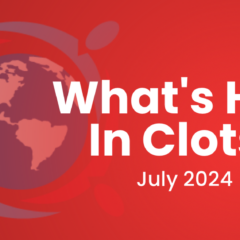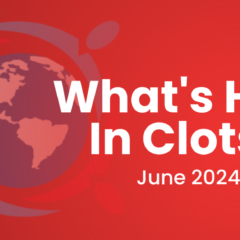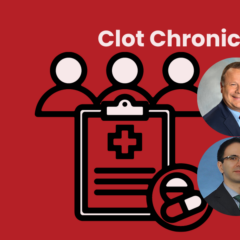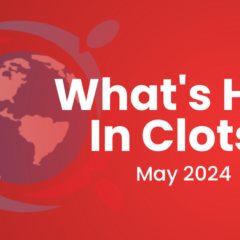Last updated on
Clot Chronicles: Rethinking Risk? The ABC Risk Score for Stroke and Bleeding
Hello, my name is Christian Ruff, and I’m the Director of General Cardiology at Brigham and Women’s Hospital and a clinical trialist at the TIMI Study Group.
Obviously, risk prediction is incredibly important in all fields of medicine, and that’s certainly true for atrial fibrillation (Afib). We know that patients with Afib have an increased risk of ischemic stroke, and those strokes tend to be either fatal or very devastating, leaving people with permanent neurologic disability. And we know that giving a blood-thinner or an anticoagulant reduces that risk by approximately 70-80%, so they’re very effective.
But anytime that you prevent clotting, by giving a blood-thinner or an anticoagulant, you’re going to increase the risk of bleeding. And so, when you have a patient sitting in front of you, you’re really weighing two competing risks – 1) what is their underlying risk of stroke from their disease, and 2) is it high enough that they’d warrant treatment with a medication that’s going to increase their risk of bleeding, and potentially (although much less common), serious bleeding?
There have been well-established, predominantly clinical risk scores that help us assess, for an individual patient, what their risk of both stroke and bleeding is. The most straightforward is probably the CHA2DS2-VASc score. We were using an earlier version of that, the CHA2DS2 score, to predict the risk of stroke in patients with atrial fibrillation. We know now that other risk factors, which were incorporated into the CHA2DS2-VASc score, do a pretty good job of estimating the risk of stroke in Afib.
And the way the CHA2DS2-VASc score has been used is basically anybody with certainly two—but potentially one—risk factor has a high enough risk of stroke to warrant anticoagulation. But I think what is not as well known is that if you look at how well the score predicts an individual patient’s risk—whether their risk is 5%, 8%, 12%—the CHA2DS2-VASc score actually doesn’t perform all that well. It really establishes more of a threshold. But whether a patient’s individual risk is not 2% but 5% or 6%, people feel that’s not quite as important because once you’re above this threshold, it’s sort of not as relevant what your specific risk is.
But of course, if we have the ability to better predict the risk of stroke, why wouldn’t we use simple tools? And I think it’s been well established, primarily from the clinical trials used to study the novel oral anticoagulants, that bleeding stroke risk scores that incorporate not only clinical factors but commonly used biomarkers—such as NT-proBNP, which we use in heart failure, or troponin, which we use in coronary disease—are very powerful predictors of ischemic stroke in patients with Afib.
So, by combining simple clinical risk scores, such as age and other factors, as well as these biomarkers, you have a much better predictor of risk. And that’s essentially what the ABC stroke risk score does – it combines clinical risk factors with key biomarkers that predict the risk of stroke. And when you compare that to a CHA2DS2-VASc score, it’s actually much better at predicting an individual patient’s exact risk of stroke, because patients want to know, in this era of precision medicine, just what their risk is.
Now the bleeding risk scores have been a lot more complicated. People probably, in the clinical community, are aware of scores such as HEMMOR2HAGES or HAS-BLED, and we know that they were popular for quite a bit of time. But in the most recent iteration of the guidelines, there is no mention of bleeding risk scores. One of the key problems is that the bleeding risk scores used clinical variables that were the very same clinical variables that predict the risk of ischemic stroke. So, in patients who have a high risk of ischemic stroke, those bleeding risk scores such as HAS-BLED predicted high rates of bleeding.
That’s not very helpful, right? Because what you want to know is whether a patient’s stroke risk low enough and their bleeding risk high enough that maybe that specifically wouldn’t warrant being on a blood thinner. That was the main problem with HAS-BLED, which is why all of the international guidelines and US guidelines dropped the use of the HAS-BLED score, because you could never find a patient using CHA2DS2-VASc or HAS-BLED where their risk of serious bleeding was outweighed by the benefit of being on a blood-thinner.
And I think this is where some of the real excitement is in the risk stratification biomarker community; through work actually done through one of the clinical trials, there ended up being a biomarker called GDF15, which is a biomarker that represents elevated stress or injury or inflammation, that seemed exquisitely tied to the risk of bleeding. And that’s what was really the holy grail when you talk about bleeding risk stratification. We know the elderly and patients with high blood pressure are at risk for stroke and bleeding, but is there a factor that we can measure that just represents bleeding risk isolated from a risk of stroke?
If you incorporate this marker, GDF15, with hemoglobin and other common clinical variables collected, you get an ABC bleeding risk score, and it turns out that that score is much more accurate than HAS-BLED in predicting the risk of bleeding. And what I think is the most important aspect of the ABC bleeding risk score is if we look at the field of Afib, we see that even in the United States, about 50% of patients who have a guideline indication for anticoagulation receive one. The most common reason physicians or patients don’t either prescribe or take an anticoagulant is risk of bleeding.
But as physicians, we tend to grossly overestimate the risk of bleeding. And, if you look at a combination of the ABC bleeding risk score and HAS-BLED score, the primary thing the ABC bleeding risk score does is it recalibrates risk; it actually down-classifies patients who we thought were at a high risk of bleeding but are at much lower risk than we would have guessed based on their HAS-BLED score. So, my sense is actually for stroke prediction, the ABC stroke score is much more accurate, but because the CHA2DS2-VASc score is used as a binary thing—you either have one or two variables, yes/no anticoagulation—it probably won’t change practice as much because the CHA2DS2-VASc score is sort of inculcated in clinical practice.
I actually have more promise for the ABC bleeding risk score because I know as a physician, we’re very tentative to prescribe anticoagulants to the elderly, frail patients at risk of bleeding. And if we do take the time to measure the ABC bleeding risk score, particularly around this very exciting biomarker (GDF15) that seems to be exquisitely associated with the risk of bleeding, we actually may see a patient in front of us who may be in their eighties or nineties, maybe has fallen before, and we may actually find that their bleeding risk is a lot lower than we initially thought just by eyeballing them. That may give us the comfort to prescribe them an anticoagulant, which we know could potentially save them from the devastation of an ischemic stroke.
For Clot Chronicles, this is Dr. Christian Ruff.



